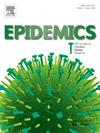模拟非洲猪瘟病毒在商业猪舍内的传播动态:量化多种传播途径的贡献
IF 2.4
3区 医学
Q2 INFECTIOUS DISEASES
引用次数: 0
摘要
非洲猪瘟病毒(ASFV)在猪舍内通过直接和间接途径传播。确定和量化猪舍内ASFV传播的作用对于制定疾病控制策略至关重要。我们建立了一个随机传播模型,通过商业猪舍内的传播途径来研究非洲猪瘟的传播动态。我们考虑了三种疾病动力学水平上的七种传播途径:围栏内、围栏之间和房间内传播,以及猪在房间内围栏之间的转移。我们模拟了不同大小和布局的猪舍内ASFV的传播,每个猪舍中位数为32个猪圈(IQR: 28-40),每个猪圈中位数为34头猪(IQR: 29-36)。我们的模型可以跟踪每个笔中的病毒载量,并在笔的水平上监测疾病状态。结果表明,笔间传播途径对传播的贡献最大,占66.76%,笔内传播途径和室内传播途径分别占26.12%和7.12%。猪栏间的鼻对鼻接触是主要传播途径,平均占46.04%。另一方面,围栏内的气溶胶传播贡献最低,占不到1%。此外,我们表明猪在猪圈之间的日常转移并不影响非洲猪瘟的传播。平均而言,在房间一级,被动每日监测和以死亡率为重点的监测相结合的方法能够在18天(IQR: 16-19)内发现非洲猪瘟病毒。该模型使我们能够监测房间内病毒载量随时间的变化,揭示出一个月后,大多数病毒载量积聚在靠近排气扇的笔中。这项工作大大加深了我们对美国商业养猪场中ASFV传播的理解,并强调了在室内实施ASFV对策行动时应优先考虑的主要传播途径。本文章由计算机程序翻译,如有差异,请以英文原文为准。
Modeling the transmission dynamics of African swine fever virus within commercial swine barns: Quantifying the contribution of multiple transmission pathways
The transmission of African swine fever virus (ASFV) within swine barns occurs through direct and indirect pathways. Identifying and quantifying the roles of ASFV dissemination within barns is crucial for developing disease control strategies. We created a stochastic transmission model to examine the ASFV dissemination dynamics through transmission routes within commercial swine barns. We consider seven transmission routes at three disease dynamics levels: within-pens, between-pens, and within-room transmission, along with the transfer of pigs between pens within rooms. We simulated ASFV spread within barns of various sizes and layouts from rooms with a median of 32 pens (IQR: 28-40), where each pen housed a median of 34 pigs (IQR: 29-36). Our model enables tracking the viral load in each pen and monitoring the disease status at the pen level. Results show that between-pen transmission pathways exhibited the highest contribution in spread, accounting for 66.76%, whereas within-pen and within-room pathways account for 26.12% and 7.12%, respectively. Nose-to-nose contact between pens was the primary dissemination route, comprising an average of 46.04%. On the other hand, aerosol transmission within pens had the lowest contribution, accounting for less than 1%. Furthermore, we show that the daily transfer of pigs between pens did not impact the spread of ASFV. On average, at the room level, the combined approach of passive daily surveillance and mortality-focused surveillance enabled ASFV detection within 18 (IQR: 16-19) days. The model allows us to monitor the viral load variation across the room over time, revealing that most of the viral load accumulates in pens closer to the exhaust fans after a month. This work significantly deepens our understanding of ASFV spread within commercial swine production farms in the U.S. and highlights the main transmission pathways that should be prioritized when implementing ASFV countermeasure actions at the room level.
求助全文
通过发布文献求助,成功后即可免费获取论文全文。
去求助
来源期刊

Epidemics
INFECTIOUS DISEASES-
CiteScore
6.00
自引率
7.90%
发文量
92
审稿时长
140 days
期刊介绍:
Epidemics publishes papers on infectious disease dynamics in the broadest sense. Its scope covers both within-host dynamics of infectious agents and dynamics at the population level, particularly the interaction between the two. Areas of emphasis include: spread, transmission, persistence, implications and population dynamics of infectious diseases; population and public health as well as policy aspects of control and prevention; dynamics at the individual level; interaction with the environment, ecology and evolution of infectious diseases, as well as population genetics of infectious agents.
 求助内容:
求助内容: 应助结果提醒方式:
应助结果提醒方式:


